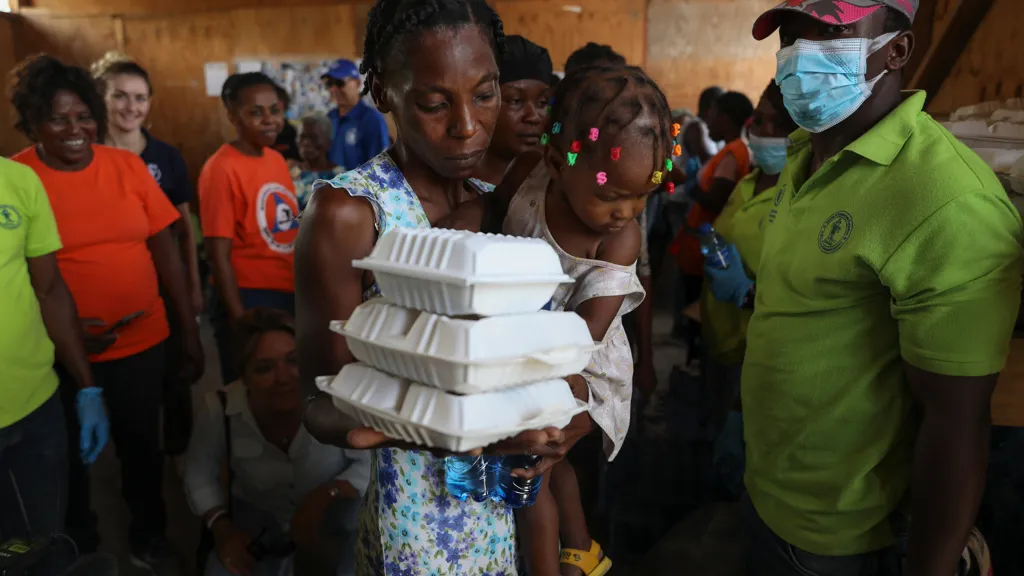In advance of a storm, the World Food Program typically stages 3,000 metric tons of food, enough to feed 200,000 people for a month. But the current supplies allow enough to feed only about 30,000 people for a month, the agency said.
"You can see there is a big gap in terms of our response," said Wilfred Nkwambi, the head of programs for the World Food Program in Haiti.
Budget shortfalls at the World Food Program have hit Haiti hard. The agency, the main food supplier for the country's vulnerable populations, recently announced cutbacks in food deliveries for internally displaced people.
As Hurricane Melissa floods southern Haitian cities and leaves hundreds of additional families homeless, the authorities are worried that other nonprofit organizations that usually supply food will not have enough to go around.
The threat posed by the storm adds to Haiti's challenges, which has been plagued by gang violence. More than 1.3 million people have been displaced by violence, and degraded roads hinder access to isolated areas.
Homes are often precariously built, and many people are concentrated in at-risk areas, exacerbating the need for help in a country with limited capacity to make contingency plans in the face of natural disasters.
The World Food Program is financed by donors around the world, many of which have shifted priorities to Gaza and Ukraine, Mr. Nkwambi said. More supplies are expected in the coming days, and about 9,500 households in Haiti have already received cash assistance from the food program, he added.
The southern areas of Haiti have been doused with rain for several days, flooding about 450 homes, the authorities said.
Hurricane Melissa caused significant damage this weekend in Marigot, on Haiti's south coast. Strong winds destroyed numerous banana plantations, damaged several houses and tore off roofs. The south part of Haiti has been on red alert for more than two days because of heavy rain and strong winds.
Three people have died, including a man in his 70s who was killed when a tree fell.
Several rivers have also flooded, the civil defense authorities said.
In Ile-a-Vache, an island of 12,000 inhabitants off the southern coast of Haiti, high winds and falling trees damaged houses, according to the mayor, Jean Yvres Amazan. Rough seas have also cut the island off from coastal shipping for three days.
"The situation of the island's citizens is serious," Mr. Amazan said on Sunday. "The sea is very rough."
Haiti's Civil Protection agency reported on Sunday that 350 shelters were open in the southern peninsula housing 900 families.
Mr. Nkwambi said he visited several shelters over the weekend and found people sleeping on the floor with no supplies. "They don't have basic things," he said.
As the storm has shifted farther west, the southern area of Haiti is less likely to be severely affected, but the authorities were still worried that the northern cities could see storm conditions once Melissa turns north, he said.
Pierre Marie Boutin, the head of the civil protection office in the South Department, said the towns of Charbonnières and Saint Jean du Sud, along with a part of Les Cayes, had been affected by storm surge. Coastal roads were cut off by rising seas.
In Les Cayes, La Tourterelle beach was underwater by Sunday and the wharf was damaged. Streets there were flooded on Monday, according to videos shared with The New York Times.
The civil protection authorities warned that preparedness efforts in several communities were hampered by the presence of armed gangs.
The communities of Petite-Rivière de l'Artibonite, L'Estère and La Chapelle are controlled by armed gangs, keeping them out of reach from the authorities.
Communication is often hampered because gangs have been targeting infrastructure.
Several small and medium-size businesses dependent on solar energy had to suspend their operations, exacerbating the crisis in getting essential services, the Haitian civil protection office said.
